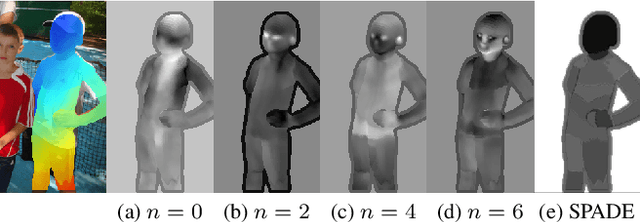Håkon Hukkelås
Does Image Anonymization Impact Computer Vision Training?
Jun 08, 2023Abstract:Image anonymization is widely adapted in practice to comply with privacy regulations in many regions. However, anonymization often degrades the quality of the data, reducing its utility for computer vision development. In this paper, we investigate the impact of image anonymization for training computer vision models on key computer vision tasks (detection, instance segmentation, and pose estimation). Specifically, we benchmark the recognition drop on common detection datasets, where we evaluate both traditional and realistic anonymization for faces and full bodies. Our comprehensive experiments reflect that traditional image anonymization substantially impacts final model performance, particularly when anonymizing the full body. Furthermore, we find that realistic anonymization can mitigate this decrease in performance, where our experiments reflect a minimal performance drop for face anonymization. Our study demonstrates that realistic anonymization can enable privacy-preserving computer vision development with minimal performance degradation across a range of important computer vision benchmarks.
Synthesizing Anyone, Anywhere, in Any Pose
Apr 06, 2023Abstract:We address the task of in-the-wild human figure synthesis, where the primary goal is to synthesize a full body given any region in any image. In-the-wild human figure synthesis has long been a challenging and under-explored task, where current methods struggle to handle extreme poses, occluding objects, and complex backgrounds. Our main contribution is TriA-GAN, a keypoint-guided GAN that can synthesize Anyone, Anywhere, in Any given pose. Key to our method is projected GANs combined with a well-crafted training strategy, where our simple generator architecture can successfully handle the challenges of in-the-wild full-body synthesis. We show that TriA-GAN significantly improves over previous in-the-wild full-body synthesis methods, all while requiring less conditional information for synthesis (keypoints vs. DensePose). Finally, we show that the latent space of \methodName is compatible with standard unconditional editing techniques, enabling text-guided editing of generated human figures.
DeepPrivacy2: Towards Realistic Full-Body Anonymization
Nov 17, 2022Abstract:Generative Adversarial Networks (GANs) are widely adapted for anonymization of human figures. However, current state-of-the-art limit anonymization to the task of face anonymization. In this paper, we propose a novel anonymization framework (DeepPrivacy2) for realistic anonymization of human figures and faces. We introduce a new large and diverse dataset for human figure synthesis, which significantly improves image quality and diversity of generated images. Furthermore, we propose a style-based GAN that produces high quality, diverse and editable anonymizations. We demonstrate that our full-body anonymization framework provides stronger privacy guarantees than previously proposed methods.
Realistic Full-Body Anonymization with Surface-Guided GANs
Jan 06, 2022



Abstract:Recent work on image anonymization has shown that generative adversarial networks (GANs) can generate near-photorealistic faces to anonymize individuals. However, scaling these networks to the entire human body has remained a challenging and yet unsolved task. We propose a new anonymization method that generates close-to-photorealistic humans for in-the-wild images.A key part of our design is to guide adversarial nets by dense pixel-to-surface correspondences between an image and a canonical 3D surface.We introduce Variational Surface-Adaptive Modulation (V-SAM) that embeds surface information throughout the generator.Combining this with our novel discriminator surface supervision loss, the generator can synthesize high quality humans with diverse appearance in complex and varying scenes.We show that surface guidance significantly improves image quality and diversity of samples, yielding a highly practical generator.Finally, we demonstrate that surface-guided anonymization preserves the usability of data for future computer vision development
Image Inpainting with Learnable Feature Imputation
Nov 02, 2020



Abstract:A regular convolution layer applying a filter in the same way over known and unknown areas causes visual artifacts in the inpainted image. Several studies address this issue with feature re-normalization on the output of the convolution. However, these models use a significant amount of learnable parameters for feature re-normalization, or assume a binary representation of the certainty of an output. We propose (layer-wise) feature imputation of the missing input values to a convolution. In contrast to learned feature re-normalization, our method is efficient and introduces a minimal number of parameters. Furthermore, we propose a revised gradient penalty for image inpainting, and a novel GAN architecture trained exclusively on adversarial loss. Our quantitative evaluation on the FDF dataset reflects that our revised gradient penalty and alternative convolution improves generated image quality significantly. We present comparisons on CelebA-HQ and Places2 to current state-of-the-art to validate our model.
DeepPrivacy: A Generative Adversarial Network for Face Anonymization
Sep 10, 2019



Abstract:We propose a novel architecture which is able to automatically anonymize faces in images while retaining the original data distribution. We ensure total anonymization of all faces in an image by generating images exclusively on privacy-safe information. Our model is based on a conditional generative adversarial network, generating images considering the original pose and image background. The conditional information enables us to generate highly realistic faces with a seamless transition between the generated face and the existing background. Furthermore, we introduce a diverse dataset of human faces, including unconventional poses, occluded faces, and a vast variability in backgrounds. Finally, we present experimental results reflecting the capability of our model to anonymize images while preserving the data distribution, making the data suitable for further training of deep learning models. As far as we know, no other solution has been proposed that guarantees the anonymization of faces while generating realistic images.
 Add to Chrome
Add to Chrome Add to Firefox
Add to Firefox Add to Edge
Add to Edge